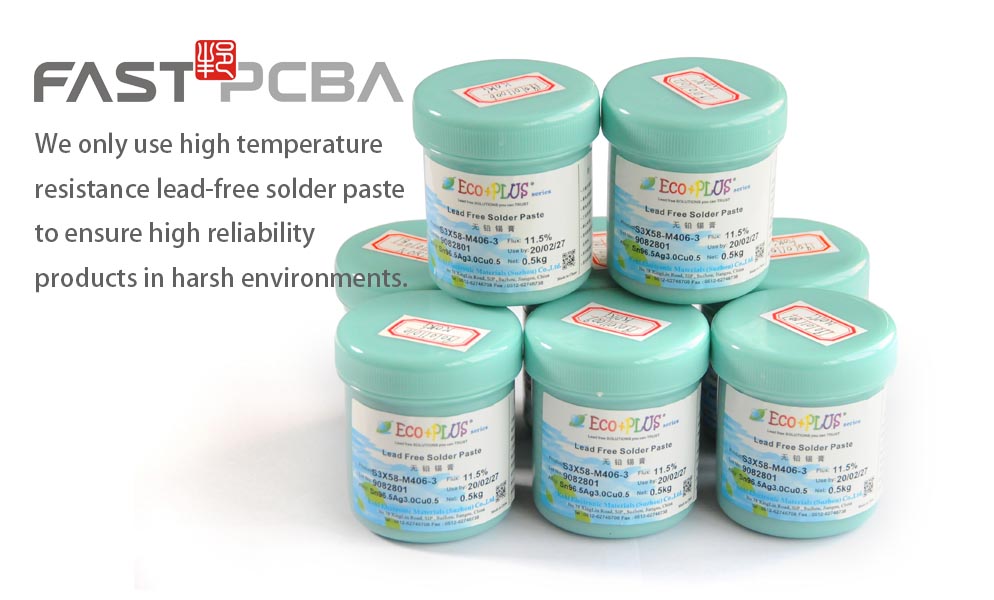About us
FASTPCBA Co.,Ltd
-
 Building 1, Senyang Electronic Technology Park, Guangming High-tech Park, Yutang Street, Guangming District, Shenzhen City.
Building 1, Senyang Electronic Technology Park, Guangming High-tech Park, Yutang Street, Guangming District, Shenzhen City.
-
 F:86-13418481618
F:86-13418481618
-
 pcba13@fastpcba.cn
pcba13@fastpcba.cn
 date:2019-12-02 15:21:10
date:2019-12-02 15:21:10
Wave soldering flux coating, welding temperature and time requirements
There are many process parameters of wave soldering, mainly including flux coating amount, printed board preheating temperature and time, welding temperature and time, printed board climbing angle and wave height, conveyor speed, cooling rate, etc. These parameters affect each other and are quite complicated, so the comprehensive adjustment of process parameters is also very important.

1.Flux coating amount
Flux coating requires a thin layer of flux on the bottom surface of the printed board. It must be uniform and not too thick. Special attention must be paid to the no-clean process. The amount of flux should be set based on the flux coating system of the wave soldering machine and the type of flux. The coating methods are mainly brushing, foaming, quantitative spraying, ultrasonic spraying, etc. The ultrasonic spraying method has the best quality, but the highest cost. Since the promotion of no-clean and lead-free processes, most of the quantitative spraying methods have been used. When using brushing and foaming methods, the flux density is generally controlled between 0.8-0.84g / cm³. If the density is found to increase, it should be adjusted to the normal range with diluent in time. Also pay attention to constantly replenish the amount of flux in the flux tank, not lower than the lowest limit position.
When the quantitative spray method is used, the flux is sealed in the container, it will not volatilize, it will not absorb moisture in the air, and it will not be polluted, so the flux composition can remain unchanged. The key is to require the spray head to be able to control the spray volume. The spray head should be cleaned frequently and the spray holes must not be blocked.
2. Welding temperature and time
The welding process is a complex process of the interaction between the welding metal surface, molten solder and air, etc. The welding temperature and time must be controlled. If the soldering temperature is low, the viscosity of the liquid solder is large, it cannot wet and spread well on the metal surface, and it is easy to cause defects such as tipping and bridging, and the surface of the solder joint is rough; if the soldering temperature is too high, it is easy to damage the components, and It will be deactivated due to the carbonization of the flux, which will accelerate the oxidation rate of the solder joints, causing problems such as black solder joints and insufficient solder joints.
The wave temperature is generally 250 ° C ± 5 ° C (lead-free is 260 ° C + 10 ° C). The actual wave temperature sprayed must be measured. You can use a 300 ° C thermometer to measure the real-time temperature curve. As a function of time and temperature, the heat absorbed by the solder joints and components at a certain temperature increases with time. The welding time of wave soldering is controlled by adjusting the speed of the conveyor belt. The speed of the conveyor belt must be based on the length of the wave soldering machine of different models. The overall preheating temperature and welding temperature shall be considered for adjustment. The welding time is represented by the time of each solder joint's contact with the wave.The general welding time is 2-4s, and the lead-free soldering is 3 ~ 5s.
 Building 1, Senyang Electronic Technology Park, Guangming High-tech Park, Yutang Street, Guangming District, Shenzhen City.
Building 1, Senyang Electronic Technology Park, Guangming High-tech Park, Yutang Street, Guangming District, Shenzhen City.
 F:86-13418481618
F:86-13418481618
 pcba13@fastpcba.cn
pcba13@fastpcba.cn